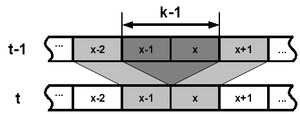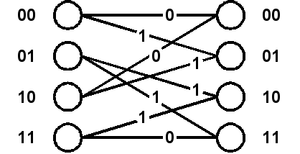Formal definition
The commonly known 1D binary CA rule 110 is defined as where
- can be finite or infinite
- is a set of two values
- is the neighborhood of size with symmetric radius
- is the local transition function rule
000 -> 0 001 -> 1 010 -> 1 011 -> 1 100 -> 0 101 -> 1 110 -> 1 111 -> 0
- is the optional boundary usually chosen not to interfere with the quiescent background of all zeros
De Bruijn diagrams
Overlap

Neighborhoods of adjacent cells are overlapping for cells. There are different overlaps or written in compact form .
Symbolic De Bruijn diagram

The De Bruijn diagram has nodes (one for each of the possible overlaps) and links (one for each of the possible neighborhoods).
preimage matrix
There are two preimage matrices, one for each of the available cell states.
Boundary conditions
There are two commonly used backgrounds, the quiescent background and the ether.
Quiescent background
The quiescent background is an infinite sequence with period of length cell.
There are always exactly two preimages for this background independently on the length of the sequence from a single cell to infinity (see the preimage network). The left and right boundary vectors are equal.

Ether background
The ether background is an infinite sequence with period of length cells. This is the prevailing background emerging from a random initial configuration.
The number of preimages of the ether configuration increases exponentially with the sequence length going to infinity. A circular lattice is used to calculate the number of preimages of the period .
Because of the exponential growth the boundary vector does not represent the number of preimages of the whole infinite background but only weights derived from the period's preimages. The value of the boundary vector depends on the position inside the period, in the next table vectors are columns for each of the 14 positions.
overlaps | boundary vectors --------------------------------------------------------------------- 00 | 0 0 0 0 2 2 0 0 1 0 0 0 0 0 01 | 0 0 0 0 0 0 2 0 0 1 1 0 2 0 10 | 0 0 0 2 0 0 0 1 0 1 0 2 0 0 11 | 2 2 2 0 0 0 0 1 1 0 1 0 0 2 --------------------------------------------------------------------- sequence | 0 0 0 1 0 0 1 1 0 1 1 1 1 1

Listing preimages
Bounded lattice
An example how to list preimages of the ether sequence on an bounded lattice
overlaps | backward preimage count vectors ---------------------------------------------------------------------- 00 | 0 0 0 0 7 7 7 0 4 4 3 2 2 1 1 01 | 0 0 0 7 0 0 4 7 0 5 4 3 2 2 1 10 | 0 0 0 0 7 7 7 0 4 4 3 2 2 1 1 11 | 7 7 7 7 0 0 0 4 3 3 2 2 1 1 1 ---------------------------------------------------------------------- sequence | 0 0 0 1 0 0 1 1 0 1 1 1 1 1
overlaps | forward preimage count vectors ---------------------------------------------------------------------- 00 | 1 2 2 2 0 1 1 0 0 1 0 0 0 0 0 01 | 1 0 0 0 2 0 0 1 0 0 1 1 1 2 2 10 | 1 0 0 0 1 0 0 0 1 0 1 1 2 2 3 11 | 1 1 1 1 0 0 0 0 1 1 0 1 1 1 2 ---------------------------------------------------------------------- sequence | 0 0 0 1 0 0 1 1 0 1 1 1 1 1
Weigths for the preimage network
overlaps | neighborhood (link) weigths ---------------------------------------- 000 | 0 0 0 0 0 7 0 0 0 0 0 0 0 0 001 | 0 0 0 0 0 0 7 0 0 4 0 0 0 0 010 | 0 0 0 0 0 0 0 4 0 0 2 2 1 2 011 | 0 0 0 0 0 0 0 3 0 0 2 1 1 2 100 | 0 0 0 0 7 0 0 0 4 0 0 0 0 0 101 | 0 0 0 0 0 0 0 0 0 0 3 2 4 2 110 | 0 0 0 7 0 0 0 0 0 3 0 2 1 1 111 | 7 7 7 0 0 0 0 0 3 0 0 0 0 0 ---------------------------------------- sequence | 0 0 0 1 0 0 1 1 0 1 1 1 1 1
overlaps | boundary vectors ---------------------------------------------------------------------- 00 | 0 0 0 0 0 7 7 0 0 4 0 0 0 0 0 01 | 0 0 0 0 0 0 0 7 0 0 4 3 2 4 2 10 | 0 0 0 0 7 0 0 0 4 0 3 2 4 2 3 11 | 7 7 7 7 0 0 0 0 3 3 0 2 1 1 2 ---------------------------------------------------------------------- sequence | 0 0 0 1 0 0 1 1 0 1 1 1 1 1

cyclic lattice
overlaps | preimage count matrices --------------------------------------------------------------------------------------- 00 | 0000 0000 0000 0000 0232 0232 0232 0000 0121 0121 0111 0110 0011 0100 1000 01 | 0000 0000 0000 0232 0000 0000 0121 0232 0000 0221 0121 0111 0110 0011 0100 10 | 0000 0000 0000 0000 0232 0232 0232 0000 0121 0121 0111 0110 0011 0100 0010 11 | 0232 0232 0232 0232 0000 0000 0000 0121 0111 0111 0110 0011 0100 0010 0001 --------------------------------------------------------------------------------------- sequence | 0 0 0 1 0 0 1 1 0 1 1 1 1 1
overlaps | boundary vectors --------------------------------------------------------------------- 00 | 0 0 0 0 2 2 0 0 1 0 0 0 0 0 01 | 0 0 0 0 0 0 2 0 0 1 1 0 2 0 10 | 0 0 0 2 0 0 0 1 0 1 0 2 0 0 11 | 2 2 2 0 0 0 0 1 1 0 1 0 0 2 --------------------------------------------------------------------- sequence | 0 0 0 1 0 0 1 1 0 1 1 1 1 1

Subset diagram transition table
from | to he left | to the right -------------------------------------------------- 0000 | <-0-0000 <-1-0000 | 0000-0-> 0000-1-> 0001 | <-0-0001 <-1-0100 | 0001-0-> 0010-1-> 0010 | <-0-0000 <-1-0101 | 1000-0-> 0100-1-> 0011 | <-0-0001 <-1-0201 | 1001-0-> 0110-1-> 0100 | <-0-0000 <-1-1010 | 0000-0-> 0011-1-> 0101 | <-0-0001 <-1-1110 | 0001-0-> 0021-1-> 0110 | <-0-0000 <-1-1111 | 1000-0-> 0111-1-> 0111 | <-0-0001 <-1-1211 | 1001-0-> 0121-1-> 1000 | <-0-1010 <-1-0000 | 1000-0-> 0100-1-> 1001 | <-0-1011 <-1-0100 | 1001-0-> 0110-1-> 1010 | <-0-1010 <-1-0101 | 2000-0-> 0200-1-> 1011 | <-0-1011 <-1-0201 | 2001-0-> 0210-1-> 1100 | <-0-1010 <-1-1010 | 1000-0-> 0111-1-> 1101 | <-0-1011 <-1-1110 | 1001-0-> 0121-1-> 1110 | <-0-1010 <-1-1111 | 2000-0-> 0211-1-> 1111 | <-0-1011 <-1-1211 | 2001-0-> 0221-1->
Garden of Eden sequences
- regular expression (the expression is left right symmetric)
- 0*1(00*1+1(1+00)*010)*1(1+00)*011(0+1)*[citation needed]
- the shortest GoE sequence
- 01010[1]
Gliders
- the ether
- (00010011011111)*
See also
- Rule 110 at MathWorld
- Rule 110 at Wolfram Atlas
- Harold V. Mcintosh, Rule 110 as it rules relates to the presence of gliders
- Rule 110 at Wikipedia